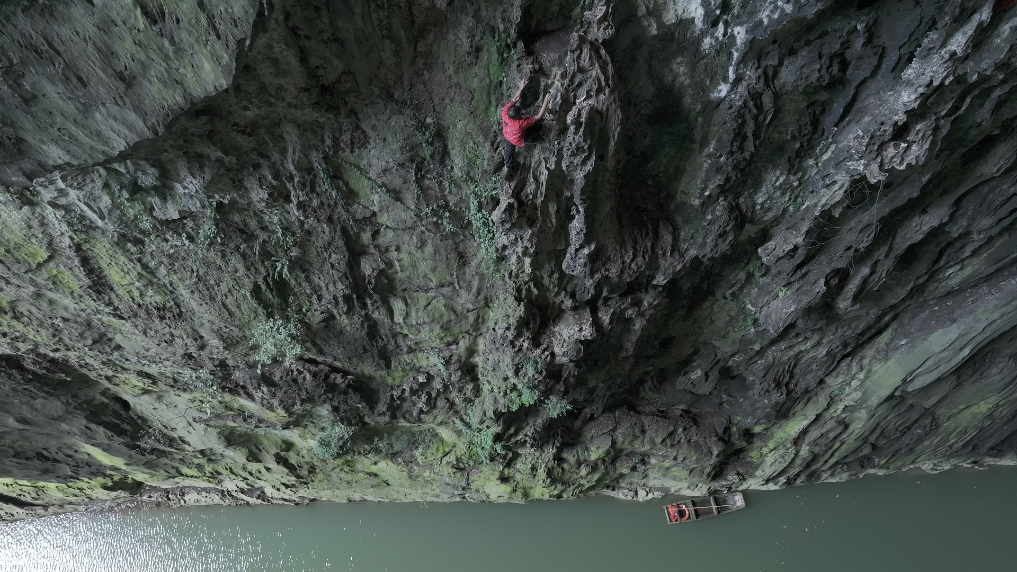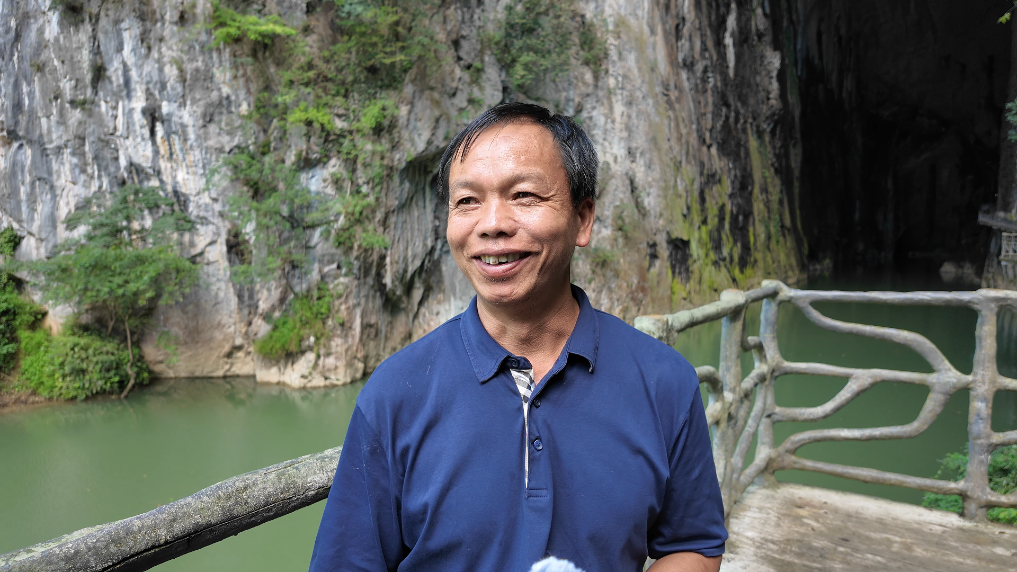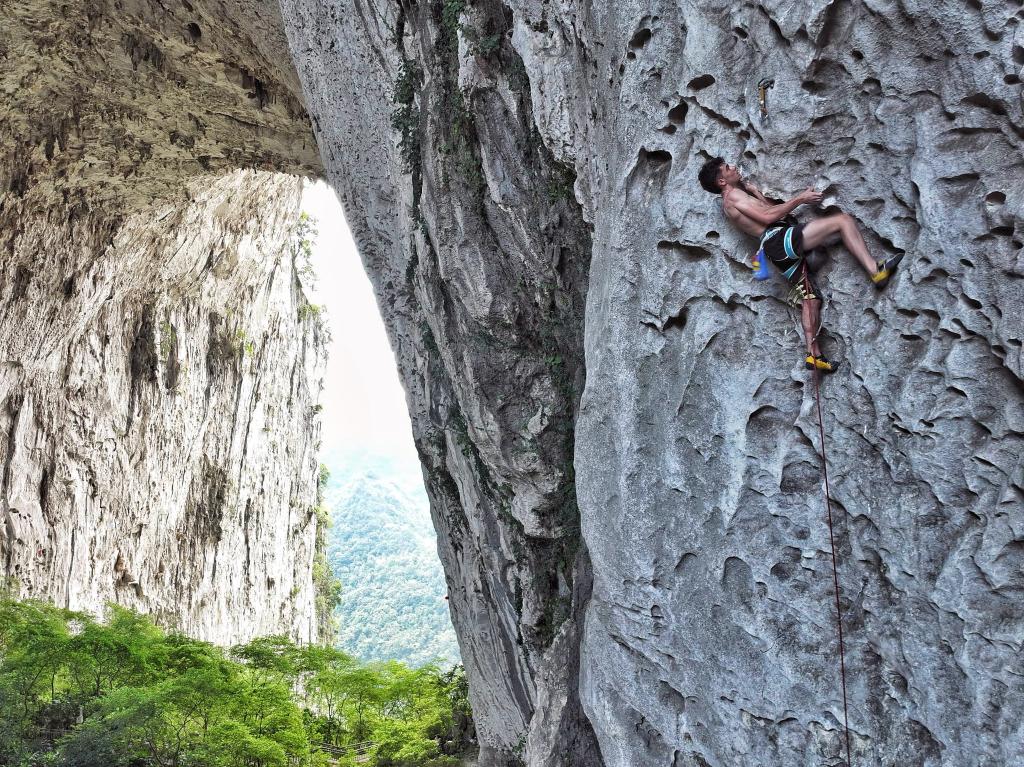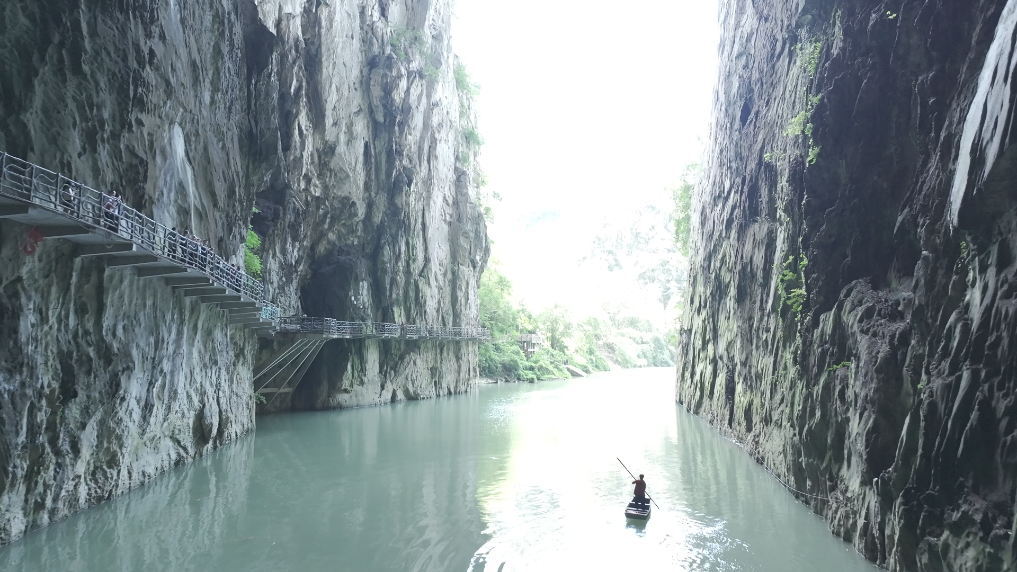
GUIYANG - As climbers from around the world competed in the 2024 Guizhou Rocktrip Rock Climbing Carnival at Getu River scenic area in Ziyun county, 120km southwest of Guiyang, 58-year-old Luo Xiaoguo, a Miao ethnic "Goro" and traditional climber, performed a solo free climb on a 100-meter-high sheer cliff in a karst cave.
In the Miao language, "Goro" refers to a climber, a term that locals have also vividly coined as "spiderman".
In Ziyun county, where karst landscapes dominate, this craft has been passed down for centuries, predating modern rock climbing that emerged in the Alps in the 18th century.
The earliest Goro were the mysterious coffin artisans who hung caskets on cliffs. Later, the term came to describe workers who collected swallows' nests and guano from these heights.
About 20 years ago, the Getu River scenic area was established, and "spidermen" like Luo Xiaoguo became part of the tourist experience, employed by the park.
ALSO READ: Climbing championships raise Guizhou's global profile
Entering the Getu River area, visitors are immediately struck by the dramatic limestone caves formed by collapsed karst systems.
The most spectacular among them is a pierced cave where morning sunlight often creates ethereal beams through the ceiling.
There are also a lot of knife-edged karst cliffs, towering hundreds of meters high. They were all once the workplaces of the Goro.
To modern rock climbers, these landscapes represent ideal big-wall routes and dream challenges. French mountaineering guide Olivier Balma visited the Getu River in 2007 and was immediately captivated by the cliffs and caves, recognizing their immense potential for new climbing routes.
"It looked like it might be a continuous 300-meter roof climb here! It's insane, but definitely not a joke," an international climber commented on route database Mountain Project in 2009.

When the Goro first encountered overseas climbers, they were still climbing barefoot. Some climbers gave Luo a few pairs of climbing shoes.
Reflecting on the experience, Luo said, "Those shoes were too tight. I still prefer wearing rubber shoes."
Today, Luo still wears the military-style green canvas "liberation shoes" commonly used in the mountainous regions of Southwest China, even outpacing two overseas climbers in a speed climbing competition.
While climbers point out that the Goro routes have more hands and footholds and are considered less difficult within modern sport climbing standards, none deny their courage and remarkable skills.
Today, nearly all of Ziyun's youth have left this ancient profession. Only a handful of Goro remain. Whether they served as coffin artisans or park employees, climbing has always been about survival in extreme environments.
READ MORE: China seen to hold potential to be sport climbing powerhouse
As economic conditions improve and career options expand, the decline of the Goro is unsurprising.
Modern rock climbing, however, has rekindled the Getu River's centuries-old climbing culture.
In 2011, Petzl, a globally renowned climbing gear manufacturer, brought over 600 climbers from around the world to Ziyun as part of their famed Petzl RockTrip series. It was the first time such an event had been held in China.
Choosing Getu River demonstrated the international climbing community's enthusiasm for this emerging destination.
Among them was famed Spanish climber Dani Andrada, who, along with his partner, made the first ascent of a multi-pitch, 210-meter roof climb in Chuangshang Cave.

Climbing website UKClimbing at the time called it "maybe the hardest continual overhanging sport route in the world."
The first ascenders named this route "Corazon de Ensueno," meaning "Heart of Dreams." "Climbing such a route is every climber's dream who wants to challenge themselves. A multi-pitch with continuous difficulty ranging from 8B to 9A is entirely different from a single-pitch high-difficulty route. For me, this is the future of climbing," Andrada said in a recorded interview. Beyond high-difficulty routes like "Heart of Dreams," the Getu River area offers a wide range of climbing spots that cater to everyone, from beginners to elite climbers.
In the months surrounding the Petzl event, over 300 new routes were established, and more than 250 of them remain well-maintained today.
After the event, Petzl produced a documentary, featuring Goro Huang Jinlin at the top of the athletes' list. Here, the bravery of ancient climbing meets the athleticism of modern sport climbing in a unique encounter.
The nature of climbing activities means climbers often stay for days or even months, contributing to local income through accommodations, food, and climbing fees.
The Getu River scenic area and local government see climbing as a potential economic driver and are keen to revitalize the ancient climbing culture.
READ MORE: Poland's Miroslaw wins inaugural sport climbing women's speed gold at Paris 2024
In 2018, rock climbing made its Olympic debut at the Youth Olympic Games. That same year, the Getu River Climbing Base, equipped with artificial competition walls, was built and hosted a leg of the Chinese Climbing League.
In 2019, several primary schools in Ziyun county also built climbing walls and held specialized climbing courses two to three times a month.
Climbing, which began with the ancient Goro, has found its young inheritors in Ziyun county.
During August's 2024 IFSC Youth World Climbing Championships, which was held in Guiyang, Ziyun county invited more than 50 young athletes from over 20 countries and regions to experience outdoor climbing at the Getu River.
Following that, the 2024 Guizhou Rocktrip Rock Climbing Carnival took place here on September 2.
Many climbers at these events praised the Chuangshang Cave for its unique climbing environment. "We come almost every year," said Wang Lingyun, a climber from Chongqing.
"The natural cave shelters us from wind and rain, making climbing less dependent on weather, and there are routes of varying difficulties, suitable for all levels." Many casual tourists also stopped to watch the competition. "They should host more events like this," said Ran Guoqiang, a tourist from Sichuan who watched the competition with his family.

It was his first time witnessing such an event, and he said it had enriched his travel experience.
Some climbers also offered suggestions for the future development of climbing at the Getu River.
"Currently, the lodging is quite basic, with limited options, and the same goes for dining. Climbers tend to stay in the county town, but the commute is too long. The scenic area could support the development of local guesthouses, which would improve the conditions for climbers while benefiting the local villagers," suggested a climber from Shanghai. "Compared to the terrain here, there are still too few routes, and they've barely changed in the past decade. The Getu should host more route-setting events or at least provide some conveniences for those passionate about route development," recommended a local Guizhou climber.
One climber on a Chinese mountaineering forum 8264 noted, "Getu River climbing is internationally famous, but for over a decade, it's been 'famous abroad but unknown at home.' There's a lack of Chinese resources. It would be great to have better-organized Chinese route guides and better online promotion of Getu climbing."
To transform Ziyun's Getu Valley, with its rich history and vast potential, into a golden brand of sports and cultural tourism is still a task that passionate enthusiasts are striving to meet.


